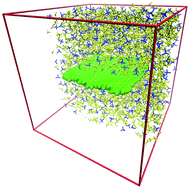Graphene exfoliation in ionic liquids: unified methodology
Abstract
Exfoliation constitutes a promising and straightforward technique to obtain a high-quality product (graphene, GRA) from an affordable source (graphite). Success of the exfoliation is blocked by inefficient solvents, which must prevent backward aggregation of GRA. The search for a solvent with optimal physicochemical properties is currently underway. This work applies a systematic methodology to rate solvents with respect to their performance in GRA exfoliation. The established methodology was applied to 1-ethyl-3-methylimidazolium tetrafluoroborate, [EMIM][BF4], an ionic liquid (IL). Having derived thermodynamic descriptors during a real-time exfoliation, we conclude that the performance of [BMIM][BF4] is mediocre. Nevertheless, [EMIM][BF4] is a suitable starting point to engineer more advanced solvents. According to binding energy decomposition, the imidazole ring drives the GRA–[EMIM][BF4] interactions, while the impact of [BF4] is significantly smaller. We discuss possible pathways to improve the performance of ILs for GRA exfoliation.

- This article is part of the themed collection: Ionic Liquids: Editors collection for RSC Advances

 Please wait while we load your content...
Please wait while we load your content...